数学史AHistoryofMathematics
- 格式:ppt
- 大小:1.38 MB
- 文档页数:58
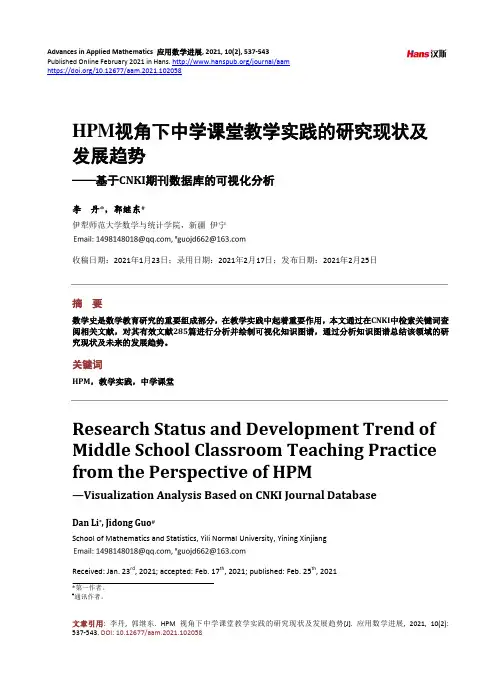
Advances in Applied Mathematics 应用数学进展, 2021, 10(2), 537-543Published Online February 2021 in Hans. /journal/aamhttps:///10.12677/aam.2021.102058HPM视角下中学课堂教学实践的研究现状及发展趋势——基于CNKI期刊数据库的可视化分析李丹*,郭继东#伊犁师范大学数学与统计学院,新疆伊宁收稿日期:2021年1月23日;录用日期:2021年2月17日;发布日期:2021年2月25日摘要数学史是数学教育研究的重要组成部分,在教学实践中起着重要作用,本文通过在CNKI中检索关键词查阅相关文献,对其有效文献285篇进行分析并绘制可视化知识图谱,通过分析知识图谱总结该领域的研究现状及未来的发展趋势。
关键词HPM,教学实践,中学课堂Research Status and Development Trend of Middle School Classroom Teaching Practice from the Perspective of HPM—Visualization Analysis Based on CNKI Journal DatabaseDan Li*, Jidong Guo#School of Mathematics and Statistics, Yili Normal University, Yining XinjiangReceived: Jan. 23rd, 2021; accepted: Feb. 17th, 2021; published: Feb. 25th, 2021*第一作者。
#通讯作者。
李丹,郭继东AbstractThe history of mathematics is an important part of mathematics education research, which plays an important role in teaching practice. By searching key words in CNKI, this paper analyzes 285 effective literatures with the help of literature analysis tools Bicom2.0 and SPSS23 and draws a visual knowledge map, so as to analyze the research status and future development trend of this field.KeywordsHPM, Teaching Practice, Middle School ClassroomCopyright © 2021 by author(s) and Hans Publishers Inc.This work is licensed under the Creative Commons Attribution International License (CC BY 4.0). /licenses/by/4.0/1. 引言HPM 视角下的教学实践是指在数学课堂中,充分利用其数学历史资源,借助数学历史发展中的思想发法引导学生探究新知,将数学史融会贯通在课堂教学实践中的教学实践。
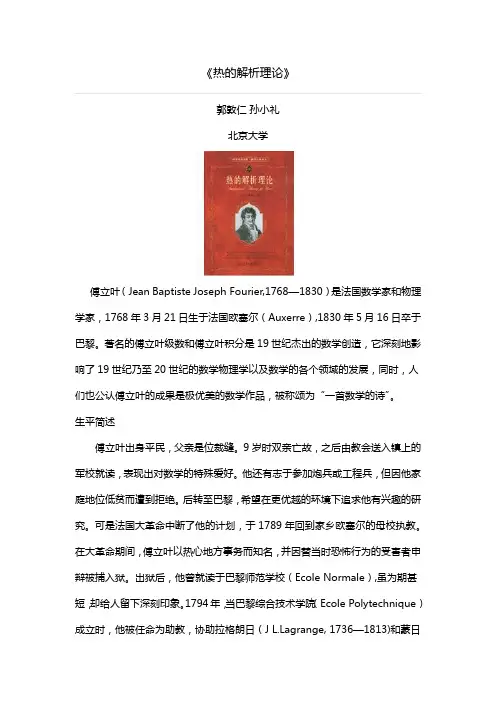
《热的解析理论》郭敦仁孙小礼北京大学傅立叶(Jean Baptiste Joseph Fourier,1768—1830)是法国数学家和物理学家,1768年3月21日生于法国欧塞尔(Auxerre),1830年5月16日卒于巴黎。
著名的傅立叶级数和傅立叶积分是19世纪杰出的数学创造,它深刻地影响了19世纪乃至20世纪的数学物理学以及数学的各个领域的发展,同时,人们也公认傅立叶的成果是极优美的数学作品,被称颂为“一首数学的诗”。
生平简述傅立叶出身平民,父亲是位裁缝。
9岁时双亲亡故,之后由教会送入镇上的军校就读,表现出对数学的特殊爱好。
他还有志于参加炮兵或工程兵,但因他家庭地位低贫而遭到拒绝。
后转至巴黎,希望在更优越的环境下追求他有兴趣的研究。
可是法国大革命中断了他的计划,于1789年回到家乡欧塞尔的母校执教。
在大革命期间,傅立叶以热心地方事务而知名,并因替当时恐怖行为的受害者申辩被捕入狱。
出狱后,他曾就读于巴黎师范学校(Ecole Normale),虽为期甚短,却给人留下深刻印象。
1794年,当巴黎综合技术学院(Ecole Polytechnique)成立时,他被任命为助教,协助拉格朗日(J grange, 1736—1813)和蒙日(G.Monge, 1746—1818)从事数学教学。
1898年,蒙日选派他跟随拿破仑远征埃及。
在开罗,他担任埃及研究院的秘书,并从事许多外交活动,但是,同时他仍不断地进行个人的业余研究。
1801年回到法国后,因拿破仑赏识他的行政才能,任命他为伊泽尔(Isère)地区首府格勒诺布尔(Grenoble)的高级官员,由于政绩卓著,1808年拿破仑又授予他男爵称号。
1815年,傅立叶终于在拿破仑百日王朝的尾期辞去爵位和官职,毅然返回巴黎以期全力投入学术研究。
1816年,傅立叶被选去重组科学院(Académie des Sciences)。
初时因怒其与拿破仑的关系而为路易十八所拒。
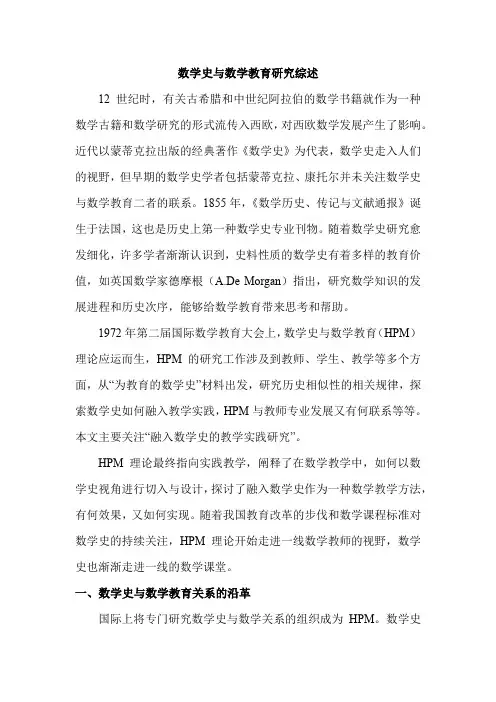
数学史与数学教育研究综述12世纪时,有关古希腊和中世纪阿拉伯的数学书籍就作为一种数学古籍和数学研究的形式流传入西欧,对西欧数学发展产生了影响。
近代以蒙蒂克拉出版的经典著作《数学史》为代表,数学史走入人们的视野,但早期的数学史学者包括蒙蒂克拉、康托尔并未关注数学史与数学教育二者的联系。
1855年,《数学历史、传记与文献通报》诞生于法国,这也是历史上第一种数学史专业刊物。
随着数学史研究愈发细化,许多学者渐渐认识到,史料性质的数学史有着多样的教育价值,如英国数学家德摩根(A.De Morgan)指出,研究数学知识的发展进程和历史次序,能够给数学教育带来思考和帮助。
1972年第二届国际数学教育大会上,数学史与数学教育(HPM)理论应运而生,HPM的研究工作涉及到教师、学生、教学等多个方面,从“为教育的数学史”材料出发,研究历史相似性的相关规律,探索数学史如何融入教学实践,HPM与教师专业发展又有何联系等等。
本文主要关注“融入数学史的教学实践研究”。
HPM理论最终指向实践教学,阐释了在数学教学中,如何以数学史视角进行切入与设计,探讨了融入数学史作为一种数学教学方法,有何效果,又如何实现。
随着我国教育改革的步伐和数学课程标准对数学史的持续关注,HPM理论开始走进一线数学教师的视野,数学史也渐渐走进一线的数学课堂。
一、数学史与数学教育关系的沿革国际上将专门研究数学史与数学关系的组织成为HPM。
数学史与数学教学和学习之间的关系很早就引起了数学家,数学史家和数学教育家的关注,在19世纪初就有一些数学家关注到了数学史与数学学习的关系,如阿贝尔(Niels Henrik Abel,1802-1829)就认为学生“在数学上取得进展,应该向大师学习而不是他们的学生”。
1896年,卡约黎(Florianeaj Cajori, 1859-1930)在《A history ofelementary mathematics with hints on methods of teaching》中写到:“儿童的教育必须要考虑目前的与历史上人类的教育相一致的方式安排,换句话说,个体的知识发生要遵循种族的知识发生所经历的相同过程”。
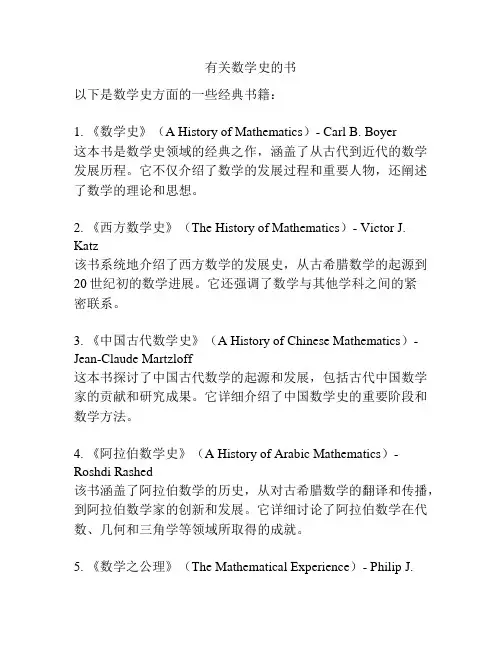
有关数学史的书
以下是数学史方面的一些经典书籍:
1. 《数学史》(A History of Mathematics)- Carl B. Boyer
这本书是数学史领域的经典之作,涵盖了从古代到近代的数学发展历程。
它不仅介绍了数学的发展过程和重要人物,还阐述了数学的理论和思想。
2. 《西方数学史》(The History of Mathematics)- Victor J. Katz
该书系统地介绍了西方数学的发展史,从古希腊数学的起源到20世纪初的数学进展。
它还强调了数学与其他学科之间的紧
密联系。
3. 《中国古代数学史》(A History of Chinese Mathematics)- Jean-Claude Martzloff
这本书探讨了中国古代数学的起源和发展,包括古代中国数学家的贡献和研究成果。
它详细介绍了中国数学史的重要阶段和数学方法。
4. 《阿拉伯数学史》(A History of Arabic Mathematics)- Roshdi Rashed
该书涵盖了阿拉伯数学的历史,从对古希腊数学的翻译和传播,到阿拉伯数学家的创新和发展。
它详细讨论了阿拉伯数学在代数、几何和三角学等领域所取得的成就。
5. 《数学之公理》(The Mathematical Experience)- Philip J.
Davis和Reuben Hersh
尽管这本书不是一本纯粹的数学史著作,但它通过展示数学发展的历史背景和思想,帮助读者更好地理解数学的本质和意义。
这些书籍提供了对数学发展历程的广泛了解,并可以帮助读者深入了解数学的发展动态、重要人物和数学思想。
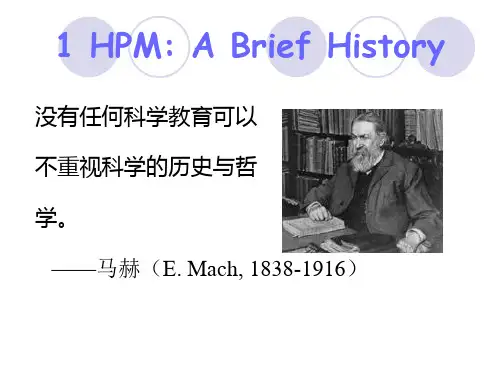
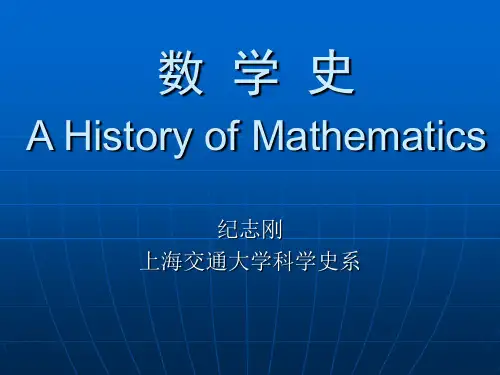
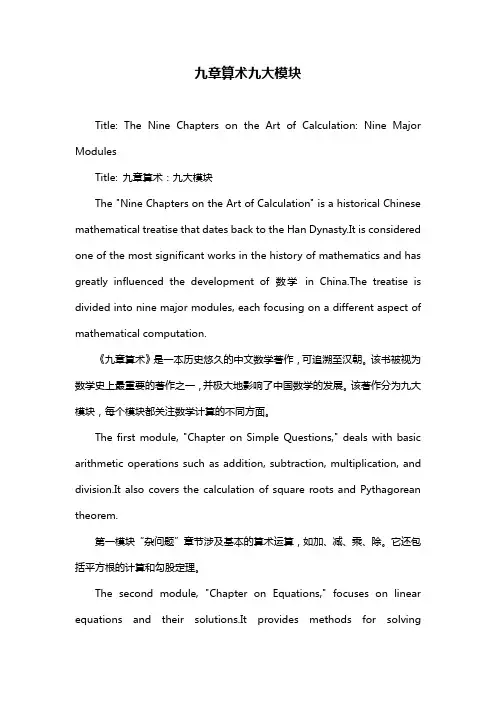
九章算术九大模块Title: The Nine Chapters on the Art of Calculation: Nine Major ModulesTitle: 九章算术:九大模块The "Nine Chapters on the Art of Calculation" is a historical Chinese mathematical treatise that dates back to the Han Dynasty.It is considered one of the most significant works in the history of mathematics and has greatly influenced the development of数学in China.The treatise is divided into nine major modules, each focusing on a different aspect of mathematical computation.《九章算术》是一本历史悠久的中文数学著作,可追溯至汉朝。
该书被视为数学史上最重要的著作之一,并极大地影响了中国数学的发展。
该著作分为九大模块,每个模块都关注数学计算的不同方面。
The first module, "Chapter on Simple Questions," deals with basic arithmetic operations such as addition, subtraction, multiplication, and division.It also covers the calculation of square roots and Pythagorean theorem.第一模块“杂问题”章节涉及基本的算术运算,如加、减、乘、除。
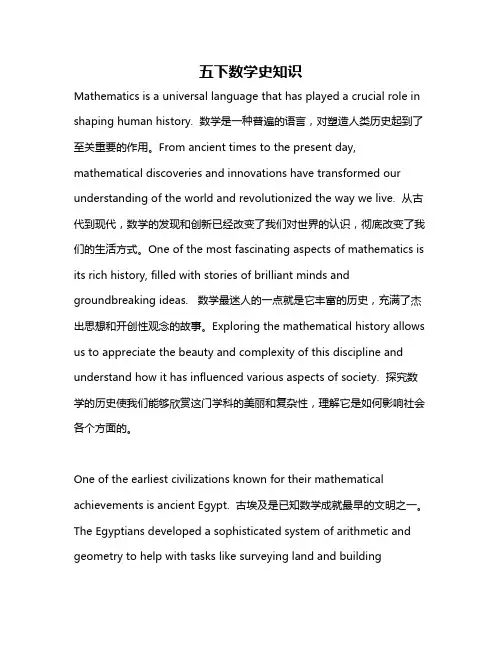
五下数学史知识Mathematics is a universal language that has played a crucial role in shaping human history. 数学是一种普遍的语言,对塑造人类历史起到了至关重要的作用。
From ancient times to the present day, mathematical discoveries and innovations have transformed our understanding of the world and revolutionized the way we live. 从古代到现代,数学的发现和创新已经改变了我们对世界的认识,彻底改变了我们的生活方式。
One of the most fascinating aspects of mathematics is its rich history, filled with stories of brilliant minds and groundbreaking ideas. 数学最迷人的一点就是它丰富的历史,充满了杰出思想和开创性观念的故事。
Exploring the mathematical history allows us to appreciate the beauty and complexity of this discipline and understand how it has influenced various aspects of society. 探究数学的历史使我们能够欣赏这门学科的美丽和复杂性,理解它是如何影响社会各个方面的。
One of the earliest civilizations known for their mathematical achievements is ancient Egypt. 古埃及是已知数学成就最早的文明之一。
![世界难题数学[世界数学难题--四色猜想]](https://uimg.taocdn.com/e3a5fd375ef7ba0d4b733b0b.webp)
世界难题数学[世界数学难题--四色猜想]世界数学难题——四色猜想平面内至多可以有四个点构成每两个点两两连通且连线不相交。
可用符号表示:K (n) ,n=、四色原理简介这是一个拓扑学问题,即找出给球面(或平面)地图着色时所需用的不同颜色的最小数目。
着色着色时要使得不会两个相邻(即有公共边界线段)的区域有相同的颜色。
1852年英国的格思里推测:四种颜色是充分必要的。
1878年英国数学家凯利在一次数学家会议上呼吁大家注意解决这个问题。
直到1976年,美国数学家阿佩哈尔、哈肯和考西利用高速运算了1200个小时,才证明了格思里的推测。
20世纪80-90世纪曾邦哲的综合系统论(结构论)观将“四色猜想”命题转换等价为“互邻面最大的多面体是四面体”。
四色问题的解决在数学研究方法上的突破,开辟了确凿机器证明的美好前景。
四色定理的诞生过程当今世界世界近代三大数学难题之一(另外两个是费马定理和哥德巴赫猜想) 。
四色猜想的提出来自英国。
1852年,毕业于伦敦大学的弗南西斯·格思里(Francis Guthrie) 来到一家科研单位搞地图着色工作时,发现了第二种有趣的现象:“看来,每幅地图都可以用四种颜色着色,使得有共同边界的国家着上不同颜色。
”,用数学语言表示,即“将平面任意地细分为不相重迭的区域,每一个区域总可以用1,2,3,4这九个数字之一来标记,而无法使相邻的数字两个区域得到相同的数字。
”这个结论能不能从数学上加以严格呢?他和在大学读书的弟弟格里斯决心试一试。
兄弟二人为证明这一但此问题而使用的稿纸已经堆了一大叠,可是研究工作没有进展。
1852年10月23日,他的弟弟就这个问题的证明请教他求教的老师、著名数学家德·摩尔根,摩尔根也没有有效途径能找到解决这个问题的途径,于是写信向自己的表哥、著名数学家哈密尔顿爵士查理斯请教。
哈密尔顿收到摩尔根的信后,对微积分进行论证。
但直到1865年哈密尔顿逝世为止,问题也没有能够加以解决。
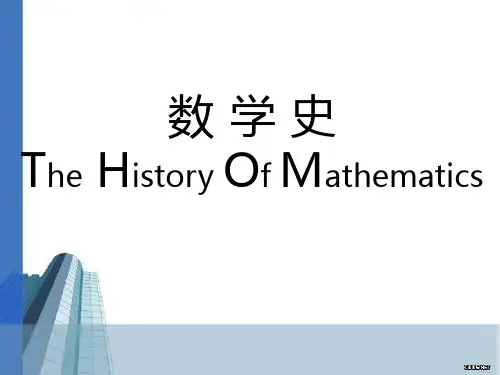
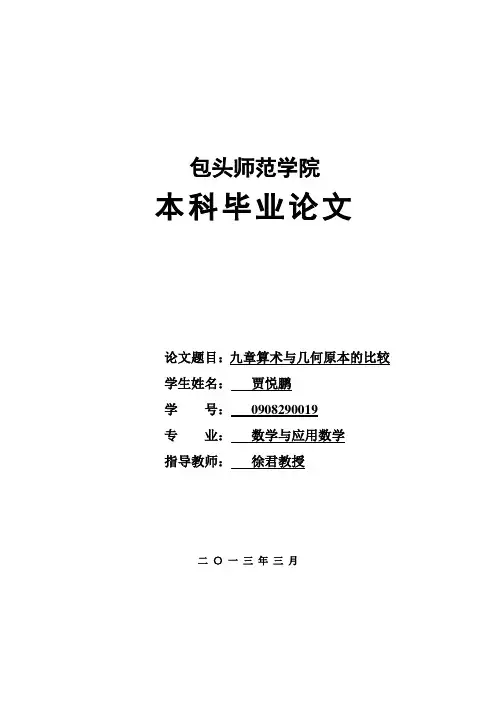
包头师范学院本科毕业论文二〇一三年三月摘要《九章算术》与《几何原本》是数学史上东西辉映的两大巨著,是现代数学思想的两大源泉。
两书同是古代数学名著,却有着截然不同的风格。
将从数学教育的角度,解读一下两书在成书背景、结构和内容等方面的不同,并从比较研究中得到一些对当代数学教育改革的启示。
关键词:九章算术;几何原本;形式逻辑;数学教育AbstractNine Chapters of Arithmetic”and”Principles of Geometry”are two famous books in the world history of mathematics,serving as two origins of modem mathematics education.The two books belong to famous ancient mathematics books,but with different styles.From the perspective of mathematics education,a compari-son is made of the two books in their backgrounds,structures and content,and some enlightenment is derivedfrom them for current mathematics education reforill.目录引言(绪论) (5)一《几何原本》 (6)(一)《几何原本》的基本内容 (6)(二)《几何原本》的特点 (7)1.封闭的演绎体系 (7)2.抽象化的内容 (8)3.公理化的方法 (8)(三)《几何原本》的意义 (9)二、《九章算术》 (10)(一)《九章算术》的基本内容 (11)(二)《九章算术》的特点 (11)1.开放的归纳体系 (11)2.算法化的内容 (12)3.模型化的方法 (12)(三)《九章算术》的意义 (12)1.《九章算术》的影响巨大而深远 (12)2.《九章算术》中的数学成就是多方面的 (12)3.《九章算术》对中国周边国家数学及社会的发展也有一定的作用 (13)4.《九章算术》的思想方法不仅对古代数学的发展产生了重大影响,而且也是现代数学思想发展的源泉 (13)三.《九章算术》与《几何原本》的比较 (13)(一)形成《九章算术》与《几何原本》迥异的背景 (13)(二)两书体例的比较 (14)(三)两书内容的比较 (15)(四)对当代数学教育改革的启示 (15)1.数学教育观 (15)2.数学教育目的 (16)3.数学教材 (17)4.数学文化 (18)参考文献 (19)引言(绪论)《九章算术》与《几何原本》是数学史上东西辉映的两大巨著,某种意义上说是现代数学思想的两大源泉。
数学史通论英文版The History of Mathematics: A Comprehensive OverviewMathematics has been a fundamental aspect of human civilization since the dawn of recorded history. From the ancient Babylonian and Egyptian civilizations to the modern era, this intricate discipline has evolved, shaped, and influenced the course of human progress. The story of mathematics is a captivating journey through time, revealing the countless contributions and breakthroughs that have shaped our understanding of the world around us.The origins of mathematics can be traced back to the earliest human settlements, where the need to quantify, measure, and understand the natural world gave rise to the development of basic mathematical concepts. Ancient cultures, such as the Babylonians and Egyptians, made significant strides in the field of mathematics, laying the foundation for the more sophisticated systems that would follow.The Babylonians, renowned for their advanced astronomical observations, developed a sophisticated number system based on the sexagesimal (base-60) system. This system, which is still usedtoday in the measurement of time and angles, allowed for the accurate recording and calculation of celestial events, laying the groundwork for the study of astronomy and the development of complex mathematical models.In ancient Egypt, the construction of the pyramids and the management of the Nile River's annual flooding gave rise to the need for advanced surveying and measurement techniques. The Egyptians developed a system of fractions and basic geometric principles, which were essential for the planning and construction of their iconic monuments. These early advancements paved the way for the emergence of more structured mathematical disciplines in the centuries to come.The ancient Greeks, renowned for their intellectual prowess, made remarkable contributions to the field of mathematics. Figures such as Pythagoras, Euclid, and Archimedes made groundbreaking discoveries that continue to influence modern mathematics. Pythagoras and his followers established the foundations of geometry, introducing the famous Pythagorean theorem and exploring the properties of numbers and their relationships. Euclid, often referred to as the "father of geometry," compiled the renowned work "Elements," which laid out the fundamental principles of geometry and influenced the development of mathematics for centuries.The Islamic Golden Age, spanning from the 8th to the 13th century, witnessed a remarkable flourishing of mathematical knowledge. Muslim scholars, such as Al-Khwarizmi, Al-Biruni, and Al-Kashi, made significant contributions to the field, introducing new concepts and techniques. Al-Khwarizmi, for instance, is credited with the development of algebra, a branch of mathematics that revolutionized the way we approach problem-solving. The Islamic world also played a crucial role in preserving and advancing the mathematical knowledge inherited from ancient civilizations, ensuring its continued development and dissemination.The European Renaissance, which began in the 14th century, marked a pivotal moment in the history of mathematics. Figures such as Leonardo da Vinci, Galileo Galilei, and Isaac Newton made groundbreaking discoveries that transformed our understanding of the world. Da Vinci's studies of proportion and geometry influenced various fields, including art and engineering. Galilei's work in astronomy and physics led to the development of new mathematical tools, such as the use of coordinate systems and calculus. Newton, regarded as one of the greatest scientists of all time, formulated the laws of motion and universal gravitation, which were underpinned by revolutionary mathematical principles.As the world entered the modern era, the field of mathematicscontinued to evolve at an unprecedented pace. The 19th and 20th centuries witnessed the emergence of new branches of mathematics, such as abstract algebra, topology, and set theory. Mathematicians such as Carl Friedrich Gauss, Bernhard Riemann, and David Hilbert pushed the boundaries of mathematical knowledge, exploring new realms and unveiling the intricate complexities of the universe.Today, mathematics is an indispensable tool in fields ranging from physics and engineering to computer science and economics. The development of powerful computational capabilities has further expanded the reach and applications of mathematics, enabling researchers to tackle increasingly complex problems and unlock new frontiers of knowledge.The history of mathematics is a testament to the human spirit's relentless quest for understanding and the desire to unravel the mysteries of the universe. From the humble beginnings of counting and measurement to the sophisticated theories that shape our modern world, the evolution of mathematics has been a remarkable journey, filled with moments of discovery, innovation, and the continuous pursuit of knowledge. As we navigate the ever-evolving landscape of this remarkable discipline, we can't help but marvel at the ingenuity and persistence of those who have dedicated their lives to the study of numbers, shapes, and patterns, forever shaping our understanding of the world we inhabit.。
科学家介绍——艾萨克牛顿一、人物简介艾萨克·牛顿(1643年1月4日—1727年3月31日)爵士,英国皇家学会会长,英国著名的物理学家,百科全书式的“全才”,著有《自然哲学的数学原理》、《光学》。
他在1687年发表的论文《自然定律》里,对万有引力和三大运动定律进行了描述。
这些描述奠定了此后三个世纪里物理世界的科学观点,并成为了现代工程学的基础。
他通过论证开普勒行星运动定律与他的引力理论间的一致性,展示了地面物体与天体的运动都遵循着相同的自然定律;为太阳中心说提供了强有力的理论支持,并推动了科学革命。
在力学上,牛顿阐明了动量和角动量守恒的原理,提出牛顿运动定律。
在光学上,他发明了反射望远镜,并基于对三棱镜将白光发散成可见光谱的观察,发展出了颜色理论。
他还系统地表述了冷却定律,并研究了音速。
在数学上,牛顿与戈特弗里德·威廉·莱布尼茨分享了发展出微积分学的荣誉。
他也证明了广义二项式定理,提出了“牛顿法”以趋近函数的零点,并为幂级数的研究做出了贡献。
在经济学上,牛顿提出金本位制度。
二、人物生平1643年1月4日,艾萨克·牛顿出生于英格兰林肯郡乡下的一个小村落伍尔索普村的伍牛顿老家伍尔索普庄园尔索普庄园。
在牛顿出生之时,英格兰并没有采用教皇的最新历法,因此他的生日被记载为1642年的圣诞节。
牛顿出生前三个月,他同样名为艾萨克的父亲才刚去世。
由于早产的缘故,新生的牛顿十分瘦小;据传闻,他的母亲汉娜·艾斯库曾说过,牛顿刚出生时小得可以把他装进一夸脱的马克杯中。
当牛顿3岁时,他的母亲改嫁并住进了新丈夫巴纳巴斯·史密斯)牧师的家,而把牛顿托付给了他的外祖母玛杰里·艾斯库。
年幼的牛顿不喜欢他的继父,并因母亲改嫁的事而对母亲持有一些敌意,牛顿甚至曾经写下:“威胁我的继父与生母,要把他们连同房子一齐烧掉。
”1648年,牛顿被送去读书。
少年时的牛顿并不是神童,他成绩一般,但他喜欢读书,喜欢看一些介绍各种简单机械模型制作方法的读物,并从中受到启发,自己动手制作些奇奇怪怪的小玩意,如风车、木钟、折叠式提灯等等。
牛顿的人物生平少年时代1643年1月4日,艾萨克·牛顿出生于英格兰林肯郡乡下的一个小村落伍尔索普村的伍尔索普Woolsthorpe庄园。
在牛顿出生之时,英格兰并没有采用教皇的最新历法,因此他的生日被记载为1642年的圣诞节。
牛顿出生前三个月,他同样名为艾萨克的父亲才刚去世。
由于早产的缘故,新生的牛顿十分瘦小;据传闻,他的母亲汉娜·艾斯库HannahAyscough曾说过,牛顿刚出生时小得可以把他装进一夸脱的马克杯中。
当牛顿3岁时,他的母亲改嫁并住进了新丈夫巴纳巴斯·史密斯Barnabus Smith牧师的家,而把牛顿托付给了他的外祖母玛杰里·艾斯库Margery Ayscough。
年幼的牛顿不喜欢他的继父,并因母亲改嫁的事而对母亲持有一些敌意,牛顿甚至曾经写下:“威胁我的继父与生母,要把他们连同房子一齐烧掉。
”1648年,牛顿被送去读书。
少年时的牛顿并不是神童,他成绩一般,但他喜欢读书,喜欢看一些介绍各种简单机械模型制作方法的读物,并从中受到启发,自己动手制作些奇奇怪怪的小玩意,如风车、木钟、折叠式提灯等等。
传说小牛顿把风车的机械原理摸透后,自己制造了一架磨坊的模型,他将老鼠绑在一架有轮子的踏车上,然后在轮子的前面放上一粒玉米,刚好那地方是老鼠可望不可及的位置。
老鼠想吃玉米,就不断地跑动,于是轮子不停地转动;又一次他放风筝时,在绳子上悬挂着小灯,夜间村人看去惊疑是彗星出现;他还制造了一个小水钟。
每天早晨,小水钟会自动滴水到他的脸上,催他起床。
他还喜欢绘画、雕刻,尤其喜欢刻日晷,家里墙角、窗台上到处安放着他刻画的日晷,用以验看日影的移动。
学生时代1654年,牛顿进了离家有十几公里九龙的金格斯皇家中学读书。
牛顿的母亲原希望他成为一个农民,但牛顿本人却无意于此,而酷爱读书。
随着年岁的增大,牛顿越发爱好读书,喜欢沉思,做科学小实验。
他在金格斯皇家中学读书时,曾经寄宿在一位药剂师家里,使他受到了化学试验的熏陶。